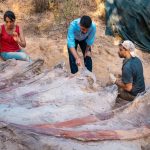The remains of what could be the largest dinosaur to ever be found in Europe are being unearthed in a back garden in the central Portuguese city of Pombal.
The remains, possibly that of a sauropod dinosaur of approximately 12m high and 25m long, are being studied by an international research team of Portuguese and Spanish palaeontologists who have been working on the site this month.
Elisabete Malafaia, a postdoctoral researcher at the Faculty of Sciences of the University of Lisbon said: “It is not usual to find all the ribs of an animal like this, let alone in this position, maintaining their original anatomical position. This mode of preservation is relatively uncommon in the fossil record of dinosaurs, in particular sauropods, from the Portuguese Upper Jurassic.”
So far, an important set of elements of the axial skeleton has been collected from the site, which includes the vertebrae and ribs of a possible brachiosaurid sauropod dinosaur. The Brachiosauridae group is composed of large species that lived from the Upper Jurassic to the Lower Cretaceous periods, approximately 160 to 100 million years ago and are characterised by the presence of markedly developed forelimbs.
Some of the most emblematic dinosaur species belong to this group of sauropods, such as Brachiosaurus altithorax and Giraffatitan brancai, as well as the Portugues Late Jurassic species found in Portugal’s west region, Lusotitan atalaiensis.
The preservation characteristics of the fossils and their disposition indicate the possible presence of other parts of the skeleton of this individual, a hypothesis that will be tested in future excavations of the deposit.
Malafaia added: “The research in the Monte Agudo paleontological locality confirms that the region of Pombal has an important fossil record of Late Jurassic vertebrates which, in the last decades, has provided the discovery of abundant materials very significant for the knowledge of the continental faunas that inhabited the Iberian Peninsula about 145 million years ago.”
Photo courtesy of Instituto Dom Luiz (Faculty of Sciences of the University of Lisbon) (Portugal).












